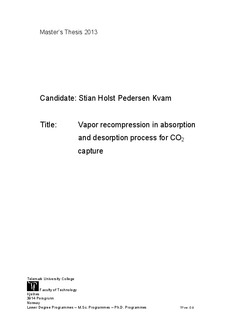| dc.contributor.author | Kvam, Stian Holst Pedersen | |
| dc.date.accessioned | 2015-09-25T11:05:05Z | |
| dc.date.accessioned | 2017-04-19T13:17:55Z | |
| dc.date.available | 2015-09-25T11:05:05Z | |
| dc.date.available | 2017-04-19T13:17:55Z | |
| dc.date.issued | 2015-09-25 | |
| dc.identifier.citation | Kvam, S.H.P. Vapor recompression in absorption and desorption process for CO2 capture. Master thesis, Telemark University College, 2013 | |
| dc.identifier.uri | http://hdl.handle.net/11250/2439010 | |
| dc.description.abstract | Due to high emissions of CO2 and the impact it has on our environment, CO2 capture from gases is becoming more and more important. There has been performed a lot of work regarding simulation of CO2 removal at TUC However, little has been done on comparison of different tools. In this thesis, three different CO2-capture configurations have been simulated using two different process simulators, Aspen HYSYS and Aspen Plus. In Aspen HYSYS, Kent-Eisenberg and Li-Mather was used as equilibrium models while eNRTL (electrolyte Non-Random Two-Liquid) was used in Aspen Plus. Both equilibrium and rate-based simulations were performed in Aspen Plus. The configurations simulated were a standard post-combustion process, vapor recompression and vapor recompression combined with split stream. CO2 removal efficiency was kept at 85% and Murphree efficiency was kept constant at 0.25. Number of stages in the absorber varied in some cases. The energy consumption was then compared for all the cases. The energy consumption for the standard post-combustion process was calculated to 3.37 – 4.26 MJ/kg CO2. The Aspen Plus equilibrium model calculated the lowest energy consumption while the Aspen Plus rate-based model calculated the highest. The equivalent energy consumption for vapor recompression was calculated to 2.92 – 3.82 MJ/kg CO2. The equivalent energy consumption is reboiler duty + 4 times compressor duty. The Aspen HYSYS Li-Mather model calculated the lowest value while the Aspen Plus rate-based model calculated the highest. The optimum pressure before compression was found to be 1.2 bar for all cases except for the rate-based calculation of vapor recompression combined with split stream. The equivalent energy consumption for vapor recompression combined with split stream was calculated to 3.0 – 4.1 MJ/kg CO2. The Aspen HYSYS Li-Mather model calculated the lowest energy consumption while the Aspen Plus rate-based model calculated the highest. The pressure before compression was kept at 1.2 bar. The different programs and models calculated an improvement in equivalent energy consumption for the vapor recompression configuration varying from 0.21 – 0.50 MJ/kg CO2. The Aspen Plus equilibrium model calculated the lowest improvement while Kent-Eisenberg and Li-Mather calculated the highest. For vapor recompression combined with split stream, the improvement varied from 0.15 – 0.39 MJ/kg CO2. Aspen Plus rate-based calculated the lowest value while Aspen HYSYS Li-Mather calculated the highest. This process configuration proved difficult to simulate using the rate-based model. The results indicate that the vapor recompression configuration is considered to be the most reasonable configuration for reducing the energy consumption. This is in agreement with earlier studies. The most optimum process configuration and most optimum process parameters were calculated to be the same in almost all the simulations. | |
| dc.language.iso | eng | |
| dc.publisher | Høgskolen i Telemark | |
| dc.subject | CO2 removal | |
| dc.subject | CO2 capture | |
| dc.subject | Process simulations | |
| dc.subject | Aspen HYSYS | |
| dc.subject | Aspen Plus Equilibrium | |
| dc.subject | Aspen Plus Rate-based | |
| dc.title | Vapor recompression in absorption and desorption process for CO2 capture | |
| dc.type | Master thesis | no |
| dc.description.version | Published version | |
| dc.rights.holder | © Copyright The Author. All rights reserved | |
| dc.subject.nsi | 610 | |
